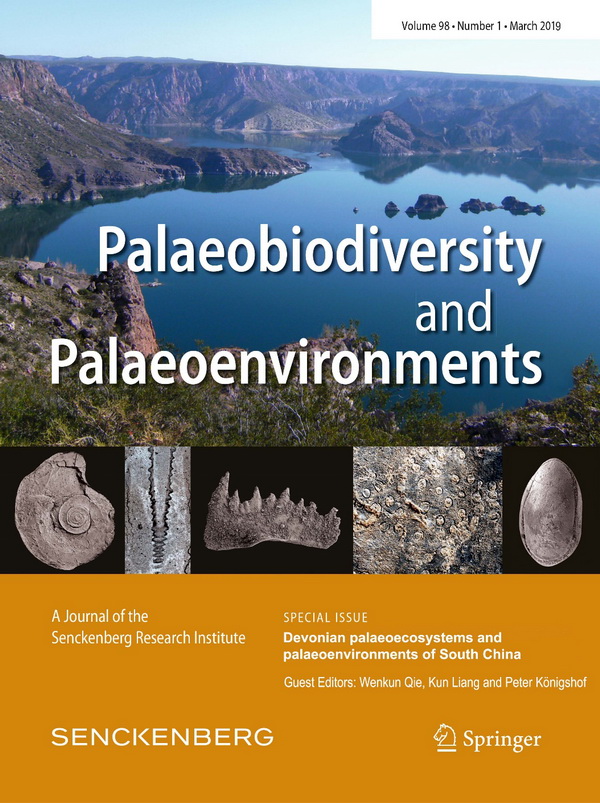|
|
| Special issue "Devonian palaeoecosystems and palaeoenvironments of South China" in "Palaeobiodiversity and Palaeoenivronments" released |

Recent advances in Devonian palaeoecosystems and palaeoenvironments of South China have been published in a special issue of “Palaeobiodiversity and Palaeoenivronments”. The eight contributions in this volume cover different fossil groups, including tentaculitids, brachiopods, conodonts, tabulate corals, ostracods, and ammonoids, meant to advance the understanding of Devonian palaeoecosystems and palaeoenvironments of South China, with a special emphasis on interplay between different fossil groups and environments during this critical period of Earth history. The issue was co-edited by Drs. Wenkun Qie and Kun Liang from the Nanjing Institute of Geology and Palaeontology, Chinese Academy of Sciences and Dr. Peter Konigshof from the Senckenberg Forschungsinstitut und Naturmuseum Frankfurt. The Devonian (419.2–358.9 Ma) was a critical period for the evolution of life in both terrestrial and marine ecosystems. It witnessed the appearances of first forest and amphibian on land, the largest metazoan reef ecosystem in Earth history, and two greatest biocrisises of the Phanerozoic (the Frasnian-Famennian and Hangenberg mass extinctions). The colonization of land by vascular plants caused major changes with respect to processes in the geo-, hydro-, and atmosphere. Continental weathering became strongly influenced by chemical processes, and thereby causing changes in riverine nutrient flux, and atmosphere CO2 concentration dropped abruptly to near modern level, all of which exert major impacts on the marine ecosystem. As many as global events, characterized by eustatic sea-level changes, anoxic/hypoxic events, and/or biological extinction/turnovers took place during the Devonian, demonstrating complex interactions between the Earth’s biotic, climatic, and environmental systems. Understanding the different fossil groups and the evolution of Devonian marine ecosystem at global or regional scale would help to gain important insights for the interplay between life and environment in deep time. South China is the most important area for the study of the Devonian system in China, where all the stratotype sections for the Chinese regional stages were established in shallow water facies of this region. Following the Kwangsian Orogeny, a transgression occurred in central Guangxi during the Lochkovian, and each sequences in South China starts with some siliciclastic sediment overlying a discontinuity surface. With intensified rifting, major differentiation of lithofacies and biofacies took place in the Emsian and Givetian stages, and the deposition of extensive carbonate platform was separated by deep-water interplatform basins. As a result, there are numerous well-preserved Devonian stratigraphic successions recording a variety of lithofacies and biofacies in South China, providing excellent materials to investigate the biotic and environmental events and their possible causes and effects. This special issue includes 1 editorial and 8 scientific papers, details are as following: 4. Lu, J.F., Valenzuela-Ríos, J.I., Wang, C., Liao, J.-C. & Wang, Y. (2019). Emsian (Lower Devonian) conodonts from the Lufengshan section (Guangxi, South China).Palaeobiodiversity and Palaeoenvironments, 99(1). https://doi.org/10.1007/s12549-018-0325-4 This special issue is partly supported by the Strategic Priority Research Program (B) of Chinese Academy of Sciences (XDB26000000) and NSFC grant (41772004). |
|
|
|
